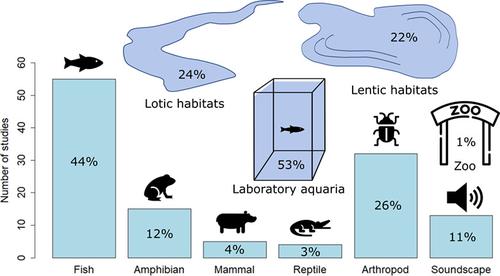当前位置:
X-MOL 学术
›
WIREs Water
›
论文详情
Our official English website, www.x-mol.net, welcomes your feedback! (Note: you will need to create a separate account there.)
The role of freshwater bioacoustics in ecological research
WIREs Water ( IF 8.2 ) Pub Date : 2020-02-12 , DOI: 10.1002/wat2.1416 Jack A. Greenhalgh 1 , Martin J. Genner 1 , Gareth Jones 1 , Camille Desjonquères 2
WIREs Water ( IF 8.2 ) Pub Date : 2020-02-12 , DOI: 10.1002/wat2.1416 Jack A. Greenhalgh 1 , Martin J. Genner 1 , Gareth Jones 1 , Camille Desjonquères 2
Affiliation

|
Conventional methodologies used to estimate biodiversity in freshwater ecosystems can be nonselective and invasive, sometimes leading to capture and potential injury of vulnerable species. Therefore, interest in noninvasive surveying techniques is growing among freshwater ecologists. Passive acoustic monitoring, the noninvasive recording of environmental sounds, has been shown to effectively survey biota in terrestrial and marine ecosystems. However, knowledge of the sounds produced by freshwater species is relatively scarce. Furthermore, little is known about the representation of different freshwater taxonomic groups and habitat types within the literature. Here we present results of a systematic review of research literature on freshwater bioacoustics and identify promising areas of future research. The review showed that fish are the focal taxonomic group in 44% of published studies and were studied primarily in laboratory aquaria and lotic habitats. By contrast, lentic habitats and other taxonomic groups have received relatively little research interest. It is particularly striking that arthropods are only represented by 26% of studies, despite their significant contributions to freshwater soundscapes. This indicates a mismatch between the representation of taxonomic groups within the freshwater bioacoustic literature and their relative acoustic contribution to natural freshwater soundscapes. In addition, the review indicates an ongoing shift from behavioral studies, often with focus on a single taxonomic group, towards field‐based studies using ecoacoustic approaches. On the basis of this review we suggest that future freshwater bioacoustics research should focus on passive acoustic monitoring and arthropod sound, which would likely yield novel insights into freshwater ecosystem function and condition.
中文翻译:

淡水生物声学在生态研究中的作用
用于估算淡水生态系统中生物多样性的常规方法可能是非选择性的和侵入性的,有时会导致易受害物种的捕获和潜在伤害。因此,淡水生态学家对无创测量技术的兴趣正在增长。被动声学监测(环境声音的无创记录)已被证明可以有效地调查陆地和海洋生态系统中的生物群。但是,对淡水物种产生的声音的了解相对较少。此外,关于文献中不同淡水生物分类群和生境类型的表示知之甚少。在这里,我们介绍淡水生物声学研究文献的系统综述,并确定未来研究的有希望的领域。审查表明,在已发表研究的44%中,鱼类是主要的分类学类别,并且主要在实验室水族箱和抽水栖息地进行了研究。相比之下,透镜状的栖息地和其他生物分类群的研究兴趣相对较小。尤其令人惊讶的是,节肢动物尽管对淡水声景做出了重大贡献,但仅占研究的26%。这表明淡水生物声学文献中的生物分类群的表示与其对天然淡水声景的相对声学贡献之间存在不匹配。此外,该评论还表明,行为研究(通常只关注一个分类组)正在逐步转向使用生态声学方法的基于实地的研究。
更新日期:2020-02-12
中文翻译:

淡水生物声学在生态研究中的作用
用于估算淡水生态系统中生物多样性的常规方法可能是非选择性的和侵入性的,有时会导致易受害物种的捕获和潜在伤害。因此,淡水生态学家对无创测量技术的兴趣正在增长。被动声学监测(环境声音的无创记录)已被证明可以有效地调查陆地和海洋生态系统中的生物群。但是,对淡水物种产生的声音的了解相对较少。此外,关于文献中不同淡水生物分类群和生境类型的表示知之甚少。在这里,我们介绍淡水生物声学研究文献的系统综述,并确定未来研究的有希望的领域。审查表明,在已发表研究的44%中,鱼类是主要的分类学类别,并且主要在实验室水族箱和抽水栖息地进行了研究。相比之下,透镜状的栖息地和其他生物分类群的研究兴趣相对较小。尤其令人惊讶的是,节肢动物尽管对淡水声景做出了重大贡献,但仅占研究的26%。这表明淡水生物声学文献中的生物分类群的表示与其对天然淡水声景的相对声学贡献之间存在不匹配。此外,该评论还表明,行为研究(通常只关注一个分类组)正在逐步转向使用生态声学方法的基于实地的研究。


























 京公网安备 11010802027423号
京公网安备 11010802027423号